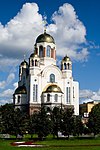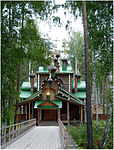Canonization of the Romanovs
Tsar Nicholas II of Russia and Family | |
|---|---|
Alexei – by the Russian Orthodox Church .
The family was killed by the Bolsheviks on 17 July 1918 at the Ipatiev House in Yekaterinburg.[4] The house was later demolished. The Church on Blood was built on this site, and the altar stands over the execution site.[5]
CanonizationOn 1 November 1981, Grand Duke Michael Alexandrovich of Russia (the younger brother of Nicholas II) and his secretary, Nicholas Johnson, were canonized by the Russian Orthodox Church Outside of Russia.[6] The two men were both murdered at Perm on 13 June 1918.[7][8] On 15 August 2000, the Russian Orthodox Church announced the canonization of Nicholas II and his immediate family for their "'humbleness, patience and meekness'" during their imprisonment and execution by the Bolsheviks.[9] On 3 February 2016, the Bishops' Council of the Russian Orthodox Church canonized Nicholas II's personal physician, Eugene Botkin, as a righteous passion bearer.[10] ControversyThe canonizations were controversial for both branches of the Jewish revolutionaries for the deaths and equating the political assassination with a ritual murder.[12]
Others rejected the family's being classified as new martyrs because they were not killed because of their religious faith. There was no proof that the execution was a ritual murder. Religious leaders in both churches also had objections to canonizing the Tsar's family because they perceived him to have been a weak emperor whose incompetence led to the revolution, and the suffering of his people. They said he was at least partially responsible for his own murder and the murders of his wife and children. For these opponents, the fact that the Tsar was said to be, in private life, a kind man and a good husband and father did not override his poor governance of Russia.[11] Despite their official designation as "passion-bearers" by the August 2000 Council, the family are referred to as "martyrs" in Church publications, icons, and in popular veneration by the people.[13][14] Since the late 20th century, believers have attributed healing from illnesses or conversion to the Orthodox Church to their prayers to Maria and Alexei, as well as to the rest of the family.[15][16] Gallery
See alsoReferences
External linksWikimedia Commons has media related to Tsar family icons.
|


